|
|
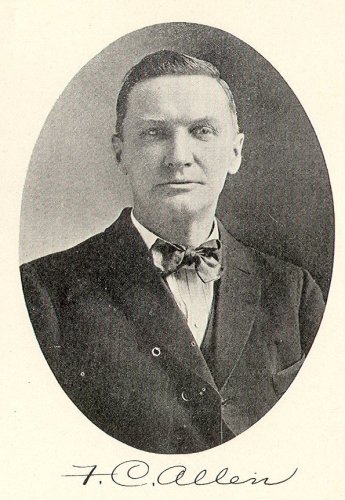 |
Retyped by Cathy Knights Reprint Edition Published Online 2004 by Joyce M. Tice
|
HAND BOOK of the New York State Reformatory At Elmira.
By Fred C. Allen, Private Secretary to the Board of Managers
This Handbook includes excerpts from board of manager’s reports and an abstract of laws relating to the reformatory.
The Summary Press
1916
Online Reprint
by Tri-Counties Genealogy & History by Joyce M. Tice 2004
The New York State Reformatory at Elmira
| Part 1 | Part 2 | Part 3 | Part 4 |
By F. C. Allen
In the year 1869 a law was enacted in the state of New York, authorizing the establishment of an institution for the reception of male felons, between the ages of sixteen and thirty, not previously convicted of any crime punishable by imprisonment in a state prison. The institution was to be located in the city of Elmira, and its name was to be the New York State Reformatory at Elmira.
In due time the construction of the reformatory was commenced. In July, 1876, its fist prisoners were received; others followed, and in January, 1877, the population numbered 164. Inmate labor was utilized to hasten the completion of the various buildings in process of construction, and in 1878, the institution was in condition to render possible the application of the system which had been devised for the discipline and employment of its inmates. Since that time, buildings have been added, from year to year, and the number of cells in the prison proper has been increased to 1,440.
The reformatory is located on a moderately high table land in a pleasant part of the city, near its western boundary; the institution wall encloses a portion of land comprising nearly eighteen acres. A farm of 280 acres, adjoining the enclosure, westward, also belongs to, and is operated in connection with the institution; the produce therefrom contributing toward the maintenance of the prisoners.
The appearance of the reformatory is stately and imposing; its principal buildings are ornate in their construction, their lofty spires and turrets taking an added air of dignity because of the institution’s elevated location, which commands an excellent view of the adjacent valley.
The purpose for which the institution was designed, is indicated by its name "reformatory." To cause all of the inmates, not incapacitated by ill health or other; infirmity, to work daily at some useful employment, both physical and mental, was considered of the first importance in the process of reformation. As a means to this end, factories and shops were built within the prison enclosure, soon after its completion, and in these, a majority of the prisoners worked, manufacturing various articles for ales. Among the first productions of this character were brushes and hardware. Supplementing the manual work, a school of letters was finally organized, in 1879, its sessions were held on certain evenings of the week, and its membership included practically all of the population. It was considered that schooling in letters was an essential factor in reformative work in that it aided in preventing the inmates from degenerating in mental power, during confinement; and aside from this, was of great value because it aided them to take a more elevated station in life, upon their release.
After the manufacturing industries had been in operation for several years, it was decided that, while this work wrought a beneficial effect in that it furnished a means of teaching the inmates to think for themselves, and aided in establishing habits of application, it was defective by reason of the fact that the different branches of manufacturing, as here conducted, were too few in number to furnish sufficient diversity of trades taught; and the further fact that the trades actually acquired were found in many instances, un-remunerative, or unsuitable for the inmates who learned them.
In view of this it was thought best to try the experiment of establishing classes for the sole purpose of trades teaching, without reference to the production of articles for sale and profit, and in the summer of 1883, a test class in clay modeling was established for the purpose of ascertaining the efficacy of specific industrial training as an aid to reformation. The experiment proved so satisfactory that trades classes in carpentry, clothing-cutting, plumbing, and telegraphy were established during the following summer. In 1888, a special building was completed for the occupancy of the trades classes, and their establishment, as a permanent feature of the reformatory work, became assured. At the close of that year, instruction was given in eleven trades and six hundred inmates were in the trades schools. A trades school director was engaged to take care of this department; the capacity of the classes was gradually increased and the course of study extended until, in 1894, it became possible to afford each inmate an opportunity to receive trade instruction. The curriculum at that time included thirty-four trades.
The school of letters, whose organization, as stated above, was completed in 1879, numbered about five hundred pupils; these were accommodated in a half-dozen large class rooms, suitably equipped with the necessary school furniture. The educational course embraced only strictly common school studies in which were included, of course, reading, writing, arithmetic, and geography. The schedule was arranged to cover a period of two years; school sessions occurring on Monday, Wednesday, and Friday evenings of each week. The educational department was in charge of a school director, who taught in the schools, and was assisted in his work of imparting instruction, by several other gentlemen, engaged for this purpose, residing in the city of Elmira.
The foregoing sketch, necessarily brief, will, it is hoped, aid the reader to a general knowledge of the origin of the reformatory, and the reasons for its establishment. Since the reception of the first prisoners, in 1876, the constant purpose of the successive boards of control has been to develop its reformative possibilities and extend its capacity. With these results in view, buildings have been added to the institution as they were needed for the use of the trades and school of letters classes. Additions to the main building were also constructed containing cell blocks for the accommodation of the increasing population. After a time, the prison enclosure, originally containing but eight acres, was enlarged, rearward; the wall now enclosing, as previously stated, approximately eighteen acres.
The reformative agencies, successfully employed in years past, are, in most instances, still in operation in the reformatory, although various modifications have been adopted where it has appeared to the management that such changes would tend to improve the original plan; among these may be mentioned the change in the number of grades, or divisions into which the population is separated, from four, to three; and the substitution of day for evening classes, in both the school of letters, and trade school departments.
We shall next endeavor to explain, with some attention to detail, the manner in which the reformatory is conducted at the time of the present writing.
The Management of the Reformatory.
The affairs of the reformatory are administered by a board of seven managers, appointed by the governor of the state, with the approval of the state senate. The term of a manager is seven years and the dates of appointment are so adjusted that during each year the term of some one of the managers expires, and another appointment is made, so that at all times a majority of the board is experienced in its duties.
In view of the fact that more than two-thirds of the prisoners committed to the reformatory are sentenced from the city of New York, or vicinity, it is considered expedient that two of the managers should be chosen from that city. At present one is also appointed from the city of Elmira, so that his advice or other assistance can be readily secured by the reformatory, when necessary, and one from the vicinity of our branch institution located at Napanoch, Ulster County, N.Y., chosen for the same reason. The other members of the board are chosen from various sections of the state without particular reference to locality.
In 1906, legislative enactment placed the board of managers of the New York State Reformatory at Elmira, in charge of the Eastern New York Reformatory, located at Napanoch, Ulster County, N.Y., changing their title to "State Board of Managers of Reformatories." The Napanoch institution at that date was a comparatively new institution, having many of its building still in process of completion, and others yet to be planned. The legislative act above referred to, conferred upon the state board of managers, power to appoint a superintendent of reformatories, to have charge of both institutions, and directed that such superintendent should appoint with the approval of the board, an assistant superintendent for Elmira, and another for the Napanoch institution, and should further appoint new officers, or where practicable, continue in office such as were already employed in the Napanoch reformatory.
The board of managers elected annually, from their number, a president, a vice-president, and a secretary and treasurer, the term of office for each being one year. The board meets, in regular session for the consideration of, and action upon reformatory matters, once in each month, the date chosen being usually near the middle of the month. Eight of these regular meetings occur at Elmira and four at the Napanoch institution. At every third regular board meeting, parole is authorized for inmates whose institutional record entitles them to same. Also, upon these occasions, a personal interview with members of the board is granted to each prisoner who may desire it. Each board meeting at the Napanoch institution usually occurs in the month immediately succeeding the month in which the board authorizes parole for inmates at the Elmira institution.
The Napanoch institution at the present wiring, is not a reformatory of original commitment, but receives all its prisoners from the Elmira institution. Its inmates earn their parole in the same manner as to the Elmira prisoners and are subject to similar regulations and routine.
The Superintendent of Reformatories.
The reformatory is in charge of a superintendent, chose by the board of managers. The executive staff under his direction, includes an assistant superintendent, a chief clerk, a steward, a physician, an assistant physician, three chaplains, a director of the school of letters, a director of the trades school, a disciplinary officer, an instruction in military, and a chief engineer. The general force comprises guards, instructions, clerks, mechanics, firemen, teamsters, and others.
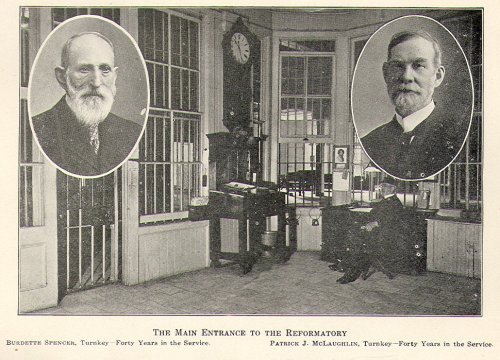
THE MAIN ENTRANCE TO THE REFORMATORY
| Burdette Spencer, Turnkey—Forty Years of Service |
Patrick
J. McLaughlin, Turnkey—Forty Years of Service
|
In addition to exercising a personal supervision of the daily affairs of the institution, the superintendent, at the beginning of each month, executes all promotions or reductions in grade; he likewise assigns to each prisoner, his place in the reformatory routine, and from time to time, grants interviews to all inmates desiring same.
At each regular meeting of the board of managers, the superintendent brings to their attention any matters transpiring subsequent to the previous meeting, upon which he may desire their advice or official action. He also submits for their consideration and approval certain regular monthly reports, including a statement of the finances of the institution, a report concerning the health, school status, promotions or reductions in grade, and general welfare of the inmates, a statement showing changes, if any, in the reformatory official roster, during the past month, and other monthly reports upon which action by the board is desired.
The Nature of Commitments.
Men are committed to the reformatory under two forms of sentence known respectively as the determinate, and the indeterminate. The determinate sentence, as its name implies, imposes a penalty of imprisonment for a definite period. The indeterminate sentence differs from the determinate in that the prisoner so committed is not sentenced for a definite period but the date of his release is determined upon by the board of managers at their discretion; but he cannot be held longer than the maximum time for which he could have been sentenced to a state prison, for the crime committed.
"Definites" or United States Prisoners.
The prisoners committed to the reformatory under determinate sentence constitute but a small portion of the prison population. They are sentenced by the United States courts for crimes against the federal government and are termed "United States Definites." Hey are received here in accordance with the state law and as previously stated, are not eligible for release under the conditions provided by the indeterminate sentence; but such prisoners may be paroled and absolutely released in the same manner as are indeterminately sentenced prisoners if, after they shall have earned their parole in the regular way, the attorney-general of the United States, upon the recommendation of the superintendent of reformatories, shall signify his approval of such parole.
State, or Indefinitely Sentenced Prisoners.
The bulk of the inmates received at the institution are committed under the indeterminate sentence and, in accordance with its provisions, may be released at the discretion of the board of managers, in accordance with its rules governing the parole and absolute release of indeterminately sentenced prisoners. The minimum term of confinement of this class of prisoners id determined by the board of managers but the maximum term is established by law which limits the power of the board of managers to detain these prisoners longer than the maximum prescribed for the crimes which they have committed.
The Release of Prisoners by Parole.
The conditions under which a prisoner may be released from the reformatory, prior to the maximum prescribed by law, are as follows: his general demeanor, and his record in school of letters, and in trades school, must be such as to give the board of managers good reason to believe that he will, if so released, become a law-abiding citizen. It is also necessary before the conditional release can be granted, that he obtain employment; such employment to be, if practicable, in the town from which he was sentenced, and at the trade learned while at the reformatory.
A prisoner released under the conditions as stated above is said to be paroled, and, upon his departure from the institution, he is given what is termed a parole paper which contains printed instructions which he must implicitly obey if he would obtain his permanent, or absolute release from the reformatory. The parole paper informs the prisoner that the board of managers has decided to parole him with the understanding that he is to be honest in his dealings; that he is to avoid evil associates and abstain from intoxicating beverages; that is he is to proceed immediately to the place of employment provided for him and there remain, steadily at work for at least six months, unless in the meantime, he shall obtain from the management of the reformatory, permission to change his location, or class of employment, or both; that each month he is to make a written report to the superintendent, giving a somewhat detailed statement in regard to himself and his surroundings, and telling whether or not he has been steadily earning wages during the past month, and if not, the reason for his failure so to do. This report, before it can properly be accepted by the superintendent, must receive the certification of a duly authorized supervising agent of the reformatory, residing in the locality from which the prisoner was sentenced. For all localities except the cities of New York and Buffalo, the chiefs of police, or other peace officers are the supervising agents for the reformatories. In the city of New York, the Elmira and Napanoch reformatories have their parole department, with the necessary equipment of offices, stenographer, and parole agents. In Buffalo, the reformatories have one parole agent, who has an office with the Charities’ Aid Association of that city. The maintenance of permanent organizations for parole supervision in New York and Buffalo, is rendered necessary by the fact that by far the major portion of our prisoners are committed from these cities. After making six satisfactory monthly reports to the management, paroled men are usually given an absolute release from the reformatory.
Parole of Invalids.
Should a prisoner become so seriously ill that, if retained in the institution, his recovery would be considered doubtful, or impossible, the board of managers, upon the recommendation of the superintendent, informed and advised by the physician, may grant him what is termed an invalid parole, provided the relatives or friends of the prisoner are willing and able to properly care for him is so released.
No Other Method of Release Except Executive Clemency.
With the exception of executive clemency, the two methods of parole outlined in the foregoing paragraphs comprise the only means for the release of indeterminately sentenced reformatory prisoners, prior to the expiration of their lawfully prescribed maximum sentences.
Prisoners Divided Into Three Grades.
The reformatory population is divided into three grades: firs, second and third. Each man upon admission to the institution, is placed in the second grade, from which, my making a good record in demeanor, school of letters, and trades school he may rise to the first grade or, by failure to do this may drop to the third. Six months of proper institutional record in the second grade ensures promotion to the first grade; a like six months in the first grade entitled the prisoner to consideration by the board of managers for parole. For improper demeanor, if sufficiently serious, reduction in grade is possible at any time. Poor school work, if below certain prescribed standards, and persisted for a month or more, also necessitates grade reduction. After reduction to the third grade, at least one promotion can be considered. Prisoners may be reduced from the first to the second, from the second to the third, or from the first to the third, but they can be promoted only one grade at a time.
The Various Grades Distinguished by Difference in Clothing or Collar Device.
The first and second grades are clothed, in winter, with black coats and gray trousers; in summer with khaki uniform; the difference in grade being denoted by a number worn upon the collar of the jacket. Red coats and trousers are worn by the third grade.
The Marking System.
Under the Elmira reformatory system it is designed that each prisoners, from the date of his admission, until granted his absolute release, shall be taught the value of self-support, and to this end his personal account is credited with a small daily amount, intended to represent wages, and is debited with the cost of all he receives, be it for meals, lodging, clothing, medical attendance, or fines incurred; nothing being furnished gratis with the exception of his first outfit of clothing, a few other necessary articles of like character. It is possible for a prisoner of average health and intelligence to defray all his institutional expenses, as enumerated above, and still have remaining to his credit when released, a small balance, sufficient to pay for his transportation to place of employment, and temporary subsistence until he receives his first wages in free life.
How the Prisoners are Boarded.
The prisoners take their meals in dining rooms, to which they are assigned according to grade. The food supplied to the three grades, is uniform in quality, but the ration of the first grades admits of a somewhat greater variety than does that issued to the second and third grades.
First grade prisoners who have been economical in their various expenditures, and have thus obtained a certain credit balance, showing a specific sum saved, occupy a separte dining room and are allowed a more extended dietary than their fellows, their accounts being duly debited with the cost of the additional items received. These prisoners are also permitted to converse while at table, another privilege not accorded to inmates using the other dining rooms.
The Rooms of the Prisoners.
The prisoners’ rooms are seven feet wide, eight feet long, and nine feet high, and each has its ventilator, opening at the roof of the institution. The walls are whitewashed and in each room is an iron bedstead, a wooden cupboard, table and chair, and an electric lamp. Closets and lavatories are at present installed in 176 of the rooms,. And it is expected that eventually all will be so equipped.
Prisoners’ Clothing Manufactured at the Institution.
With the exception of a few minor activities, including collars and neckties of prisoners going out on parole, the clothing of all the prisoners is made up at the reformatory, the material being purchased from other state institutions.
Prisoner’s First Outfit Free of Cost to Himself.
As hereinbefore mentioned, each man is allowed his first outfit, free of cost; this includes coat, vest, trousers, shirt, two suits of underclothes, cap, shoes, stockings, wash-basin, water-cut, broom, dust-pan, comb, hair-brush, tooth-brush, blacking-brush, box of backing, towel, soap, four sheets, two pillow-cases and one blanket. For the renewal of this outfit, or the purchase of certain other articles not included therein, but which are allowed him, if desired, he must rely upon his institutional earnings.
Medical Treatment.
Under ordinary circumstances, prisoners desiring medical treatment are required to report at the doctor’s office at a certain hour in the morning; but in case of serious illness, may call for the physician at any time. The assistant physician makes a daily tour of the various institution departments, conferring with such inmates as may desire medical service, and if it is considered necessary, placing their names upon a list which he afterward delivers to the senior physician, who, the next morning, summons these prisoners to his office for advice, or treatment as the case may require. Applicants for treatment may be transferred to the institutional hospital, or, if found to be shamming, required to return to their duties, the physician in charge making such disposition of the various cases as in his judgment may appear necessary. A prisoner’s account is debited with a small charge for each occasion of medical service.
Fines Imposed.
In addition to being charged for food, lodging, clothing, and medical attendance, prisoners’ accounts are debited with amounts which represent fines, imposed for the violation of institutional rules, or for failure to pass school examinations. These fines vary in amount and are designed to be commensurate, as nearly as may be, with the offense committed, or the failure incurred. Should the sum total of a prisoner’s fines reach a certain amount during any given month, that month, in so far as it concerns him, is regarded as imperfect and cannot be numbered among those entitling him to consideration for promotion in grade and eventual parole. A month during which institutional fines do not amount to the certain sum above referred to, counts for him as a perfect month and an aid in earning grade promotion and parole.
When it is considered necessary that a fine be imposed, the method followed requires that a certain printed form be filled in and handed to the disciplinary officers of the institution, reciting the offense or failure requiring the fine, giving the name of the prisoner in question, and bearing the signature of the supervising officer who issues the report. The printed forms are of two kings, termed respectively, major and minor offense reports, according to the nature of the cause for their issuance. The disciplinary officer, upon receiving one of these forms, properly filled in, proceeds to investigate the matter in order to be able to decide as to whether or not the report is just and if it should be decided to be so, to determine the amount of the fine; his decisions, of course are at all times subject to revision by the superintendent. Fines may be imposed, based upon reports issued by any citizen officer having the supervision of prisoners.
Badge of Honor.
Each prisoner, maintaining a perfect institutional record since his admission to the reformatory, is decorated, upon his promotion to the first or highest grade, with a small, metal Maltese cross. This cross is affixed to the collar of his jacket and is a badge of honor, to be retained only by continuing the perfect record which has earned it. Once forfeited, the badge of honor cannot be regained by subsequent good record.
Inmates’ Conduct Ledger.
As may be seen from the above, an indeterminately sentenced prisoner’s release upon parole may be either hastened, retarded, or prevented by his conduct and personal effort, and the quality of these is shown by the conduct ledger, a page of which is headed with his name and devoted to his record while an inmate of the reformatory. A glance at this ledger will at any time acquaint the management with a prisoner’s status as regards demeanor, trades school work, and school of letters work, the three departments or branches into which the reformatory system is divided. Here are entered all school examination markings, and where failures occur, the amount of fines imposed for same; likewise a record of all fines incurred by infractions of institutional discipline, together with the nature of the offense for which each fine is exacted.
Inmates’ Daily Routine.
With the exceptions hereinafter noted, the various tasks and exercises occupying the reformatory day, are apportioned in the following manner:
During the morning hours, until about ten o’clock, a large number of the prisoners are occupied in cleaning the rooms and corridors, repairing buildings, apparatus, etc., while others, including all new arrivals, are being drilled in military exercises. There is also at this time, in the institutional gymnasium, a class in physical culture composed of prisoners thus assigned by the physician as being in especial need of gymnastic exercise and other treatment here given. A little after ten o’clock, general military exercises begin and these occupy the remainder of the morning are participated in by the major portion of the population.
The prisoners dine at noon. The first part of the afternoon is devoted to the trades school, and there is also an afternoon physical culture class in the gymnasium. These sessions last until about half-past three; from there the prisoners pass directly to their various classes in the school of letters, and receive instruction until five o’clock, when their labors for the day are concluded. After a half-hour for supper, the prisoners retire to their rooms to rest, read or study, until their bed-time, at nine o’clock.
Wednesday, Friday, Saturday, and Sunday, form an exception to the above schedule, the respective programs for these days being as follows:
On Wednesday morning occurs the usual routine, with the addition of the semi-weekly session of the respective classes of stenography, and clothing-cutting, and the elimination of the morning military exercises. On Wednesday afternoon there is no session of the school of letters, and the sessions of the trades school classes are limited to those of printer and book binder, and a class in mechanical drawing, the latter including nearly all the trades school pupils. The military exercises and the dress parade occupy the remainder of the day.
There is no change in the institutional routine on Friday except that during the morning is held a session of the classes in stenography and clothing-cutting.
On Saturday morning the usual routine obtains with the exception that all prisoners are required to bathe, and there are no military exercises but a session of the school of inmate officers under instruction of the colonel of the regiment. In the afternoon there is no session of the school of letters, nor of the trades school; the entire time being occupied in military exercises, which conclude with dress parade beginning at a quarter to four.
The Roman Catholic and Protestant chaplains conduct their respective religious services on Sunday morning; in the afternoon, in addition to the Jewish services, in charge of the Hebrew chaplain, occur class sessions in ethics and current topics.
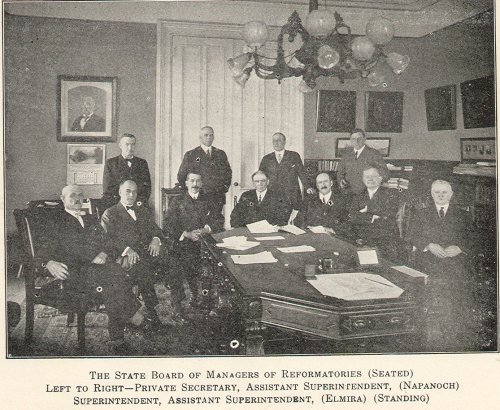
THE STATE BOARD OF MANAGERS
OF REFORMATORIES (SEATED)
LEFT TO RIGHT—PRIVATE SECRETARY, ASSISTANT SUPERINTENDENT, (NAPANOCH)
SUPERINTENDENT, ASSISTANT SUPERINTENDENT, (ELMIRA) (STANDING)
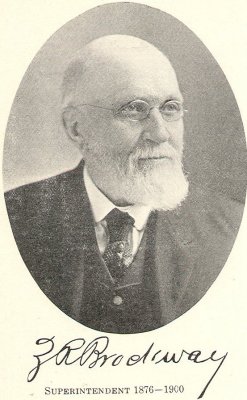 |
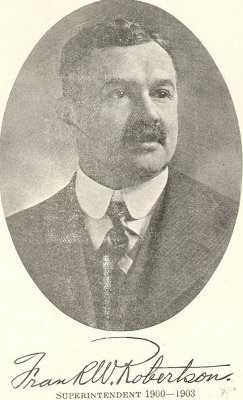 |
|
Superintendent 1876—1900 |
Superintendent 1900—1903 |
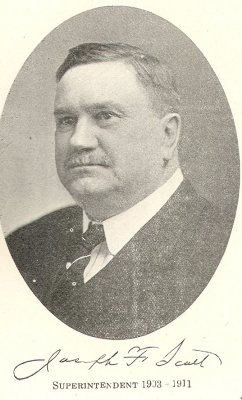 |
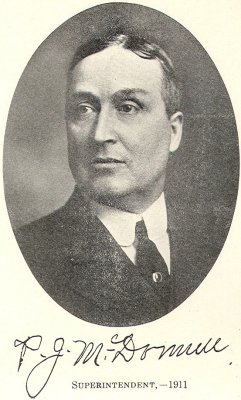 |
|
Superintendent 1903—1911 |
Superintendent 1911 |
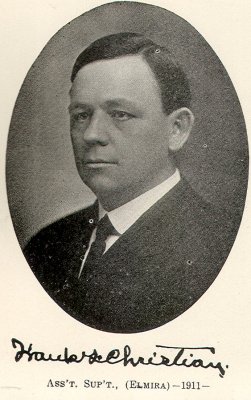 |
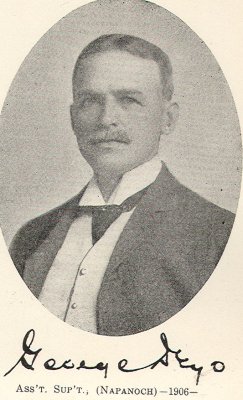 |
|
Ass’t. Sup’t., (Elmira)—1911— |
Ass’t. Sup’t.; (Napanoch)—1906— |
The School of Letters.
A citizen instructor called the school director has charge of the department of the school of letters. Upon their reception at the institution, the men are interviewed by the school director and assigned to the particular grade of the school for which, in his judgment, they are best qualified by natural intelligence and previous educational advantages.
The school director is assisted in his work by the chaplains, and a visiting lecturer, of the faculty of Elmira College; he has also an efficient corps of inmate teachers by whom, under his direction, a considerable portion of the teaching and routine work of the school is performed.
The school director visits all class sessions, for purposes of criticism and suggestion, and also conducts a semi-weekly normal class composed of all of his inmate instructors, at which methods of teaching are considered, and plans for improvement discussed.
The subjects taught in the school of letters are: arithmetic, bookkeeping, language, history, ethics, literature, civics, economics, and hygiene.
The classes in history, civics, economics, ethics, and literature are instructed personally by the chaplains and a visiting lecturer.
The class in bookkeeping is taught by a member of the citizen clerical force.
The class in arithmetic and language, are divided into eleven different grades each of which has its inmate instructor who, subject to the school director, has entire charge of and personally conducts its class recitations.
As has been previously shown, there are five school days in each week,
including Sunday. The school classes are apportioned as follows:
| Monday | Arithmetic | European History and Currently Events |
| Tuesday | Arithmetic | Civics or Economics |
| Thursday | Language | American History, and "Special A" Arithmetic |
| Friday | Language | Literature, and "Special A" Arithmetic |
| Sunday | Ethics | Question Box and Current Topics |
Courses of Study.
ARITHMETIC.
The course of study in arithmetic is arranged practically as follows:
There are eleven groups, or grades. The work in each grade consists of a four months’ course of study, examinations occurring monthly. At the conclusion of the course, the regular monthly examination includes a review of the four months’ work just completed and is the final one for the course, determining the pupils fitness to advance from the grade in question to the next higher.
The initial (eleventh) grade is made very easy for the pupil and is intended to prepare more than usually ignorant pupils to enter the regularly classified lowest (tenth) grade, from which they may advance from grade to grade until they arrive at the "Special A," or highest, and when the final examination in this grade is successfully passes, they are graduated, so far as the school of letters is concerned, from the study of arithmetic.
The following is a brief synopsis of the work in the different grades, commencing with the preparatory, or eleventh, and progressing to the first, and thence to the highest, or "Special A" Grade.
PREPARTORY, OR ELEVENTH GRADE.
First Month:
Elementary work in reading and writing numbers. Concrete practical examples involving dollars and cents. Attention lessons. Lessons and drill from arithmetic chart.
Second Month:
Continuation of above with harder practical examples and more rapid drill with chart and blackboard.
Third Month:
Continuation of the above with practice in the use of signs in combination of numbers. Very simple work in addition of columns and subtraction. Rapid work with chart and revolving blackboard is expected this month.
Fourth Month:
Continuation of preceding work. Very simple concrete examples in multiplication. Multiplication tables as far as six. Drill in fractional parts as: 1/3 of 9, ¼ of 20, etc.
Quickness and ease in use of chart and revolving blackboard is expected at the end of this month.
TENTH GRADE.
First Month:
Simple concrete examples in addition and subtraction which involve dollars and cents. Attention lessons.
Second Month:
Multiplication tables as far as 7. Develop the use of signs as follows: +, –, X, ÷, =. Place columns of figures on board and have pupils add aloud. Give exercises in oral subtraction. Continuation of simple concrete examples in additional and subtraction.
Third Month:
More difficult examples in addition and subtraction. Introduce simple concrete examples in multiplication by one figure. Continue blackboard work in abstract addition and subtraction.
Fourth Month:
Multiplication tables to 9. Drill in fractional parts, as 1/3 of 12, ½ of 14, ¼ of 20, etc. Concrete work in addition, subtraction, and simple multiplication.
NINTH GRADE.
First Month:
Review of previous sets continued. Simple concrete examples in addition, subtraction, and multiplication. Simple mental arithmetic. Revolving blackboard. Multiplication tables. Fractional parts. U. S. Money.
Second Month:
Same as above. Counting by 2’s and 3’s.
Third Month:
Same as above with increase in difficulty and amount. Multiplication.
Fourth Month:
Review of term’s work.
EIGHTH GRADE.
First Month:
Careful connection with work of previous set. Difficult addition and subtraction and multiplication in concrete examples. Mental work and drill with view to drawing inferences and reasoning. Multiplication tables. Fraction parts. U.S. Money. Division begins.
Second Month:
Same as above and division with divisor of not more than two figures.
Third Month:
Same as above and simple examples in division with divisor of not more than three figures.
Fourth Month:
Review of term’s work.
SIXTH GRADE.
First Month:
Elementary work in developing the idea of a fraction. Common fractions developed. Numerator, denominator, proper and improper fractions, mixed numbers, reduction to higher and lower terms, unlike to like fractions. Mental drill in reduction.
Second Month:
Same as above and addition of fractions. Practical examples, such as occur in trades and drawing.
Third Month:
Same as above and subtraction of fractions.
Fourth Month:
Review of term’s work.
FIFTH GRADE.
First Month:
Careful connection with work of the preceding set. Much practical mental work in fractions. Multiplication of fractions introduced.
Second Month:
Same as above and multiplication of fractions with cancellation. Particular attention to trades and drawing examples involving fractions.
Division of fractions introduced.
Third Month:
Same as above and division of fractions.
Fourth Month:
Review of term’s work.
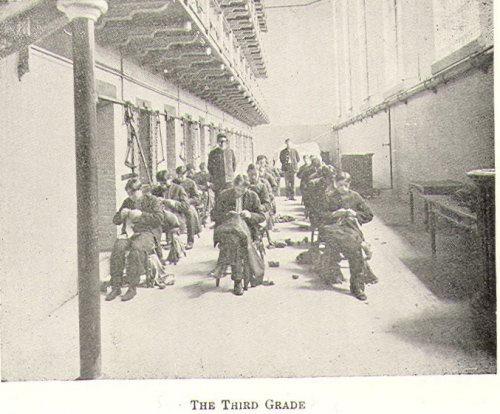
First Month:
Review of entire subject of common fractions. Denominate numbers. Table of linear measure. Examples under same involving use of both integers and fractions.
Second Month:
Same as above with tables of liquid and dry measure.
Third Month:
Same as above with avoirdupois weight.
Fourth Month:
Review of tables of time and counting.
THIRD GRADE.
First Month:
Careful connection with preceding grade. Decimal fractions explained and taught, especially their notation and numeration. Reduction to decimal, dissimilar to similar, common fractions to decimal, vice versa. Addition and subtraction. Drill in aliquot parts of 100.
Second Month:
Same as above with multiplication of decimals.
Third Month:
Same as above and division of decimals, also accounts and bills.
Fourth Month:
Review of term’s work.
SECOND GRADE.
First Month:
Careful review of both common and decimal fractions. Linear measure with practical examples involving common and decimal fractions. Board measure.
Second Month:
Same as above and square measure, including carpeting, plastering, papering, land measure, etc.
Third Month:
Same as above and cubic measure, including stone work, cubic contents of bins, cisterns, etc.
Fourth Month:
Review of term’s work.
FIRST GRADE.
First Month:
Careful review of the subject of decimal fractions. Percentage, profit and loss. Commission.
Second Month:
Same as above with commercial discount, insurance, and principles of interest.
Third Month:
Interest, discount, and promissory notes.
Fourth Month:
Review of term’s work.
"SPECIAL A’.
First Month:
Taxes, duties and customs; stocks and bonds, with problems.
Second Month:
Partnership, ratio, and simple proportion with problems.
Third Month:
Compound proportion, longitude and time, involution and evolution.
Fourth Month:
Practical measurements, and applications of square root; practical problems, and general review.
LANGUAGE.
The course of language, like that in arithmetic, is divided into grades, each embracing four months of work. There are nine grades in language, including the preparatory. After the preparatory grade, the regular course beings with the next higher grade, called the Sixth Primary, and progresses successively to the First Primary. Next higher than the First Primary comes the Second Intermediate and following that the final, or highest, the First Intermediate, which is the graduating grade in the study of language. Examinations, etc., are subject to the same rules as in the arithmetic course.
The following in a general outline of the course of study in the different language grades, subject to such supplementary work, or other modification, as the school director may from time to time deem beneficial:
Special Language Class No. 1.
All foreign born illiterates except Italians. Reading is taught by a combination of the word and sentence method.
Special Language Class No. 2.
All foreign born illiterate Italians. Reading taught same as number 1.
Special Language Class NO. 3.
Italians promoted from Special Language 2. Continuation of work in reading, spelling and writing.
PREPARATORY, OR SEVENTH PRIMARY GRADE.
First Month:
Talks about familiar things, illustrating the meaning of words by means of objects and pictures: errors in language pointed out and corrected; use of the blackboard in writing and reading simple sentences; pupils repeat sentences after the instructor, care being taken as to pronunciation and enunciation; each pupil taught to write his name and address in a neat and proper manner, using the correct pronunciation for same; all words taught should be used in original sentences; the use of the capital, and period taught; practice given in writing from copy, and in speaking.
Second Month:
Continuation of work of preceding month; pupils taught the manner in which to properly begin a letter of business or friendship; how to properly write a note to an officer of the reformatory.
Third Month:
Continuation of work of preceding month; practice in letter writing; practical drill in the use of good English words.
Fourth Month.
Continuation of work of preceding month; pupils required to learn and repeat before the class short quotations from standard authors.
SIXTH GRADE, PRIMARY.
First Month:
Continuation of work of preparatory grade; the uses of "is" and "are" explained; short lessons in reproducing in writing articles read, or descriptions given by instructor; object lessons, reading and spelling.
Second Month:
Continuation of work of first month.
Third Month:
Continuation of work of second month.
Fourth Month:
Review of work of Sixth Grade, Primary.
FIFTH GRADE, PRIMARY.
First Month:
Continuation of work of preceding grade; uses explained of the capital, period, comma, interrogation point; pupils required to learn each day quotations of not less than two lines in length, from standard authors; also required to properly read aloud, and write same; question and answer method used to develop new words at each lesson; exercises in supplying proper words where omissions have purposely been made; reading and spelling
Second Month:
Continuation of work of preceding month; name-words and action-words pointed out and their uses explained; practical neatness and accuracy required in writing simple sentences.
Third Month:
Continuation of work of preceding month: facility required in the use of simple sentences; discussions about the lessons.
Fourth Month:
Review of work of Fifth Grade, Primary.
FOURTH GRADE, PRIMARY.
First Month:
Continuation of work of preceding grade; exercises calculated to develop the faculty of imagination; spelling and dictation.
Second Month:
Continuation of work of preceding month; proper and common names; letter writing.
Third Month:
Continuation of work of preceding month; the use of abbreviations explained; action-words in present and past tense explained.
Fourth Month:
Review of work of Fourth Grade, Primary.
THIRD GRADE, PRIMARY.
Continuation of work of preceding grade; quotations of not less than three lines, from standard authors, learned each day; spelling and dictation.
Second Month:
Continuation of work of preceding month.
Third Month:
Continuation of work of previous month; exercises from language book.
Fourth Month:
Review of Third Grade, Primary.
SECOND GRADE, PRIMARY.
First Month:
Continuation of work of preceding month; uses of quotation marks explained; practice in writing sentences, stories, letters, etc.; new words in each lesson.
Second Month:
Continuation of work of preceding month.
Third Month:
Continuation of work of preceding month; uses of quotation marks explained; practice in writing sentences, stories, letters, etc.; new words in each lesson.
Fourth Month:
Review of work of Second Grade, Primary.
FIRST GRADE, PRIMARY.
First Month:
Review of work of preceding grades; exercises in the use of possessives and plurals; instructions as to proper forms for writing advertisements, notices of situations wanted, articles found, or lost, etc.; spelling and dictation.
Second Month:
Continuation of work of preceding month; how to write checks; promissory notes.
Third Month:
Continuation of work of preceding month; how to properly write dispatches to be sent by telegraph; how to write a letter ordering books, periodicals, etc.
Fourth Month:
Review of First Grade, Primary.
SECOND GRADE, INTERMEDIATE.
First Month:
Discussions; choice extracts of prose and poetry discussed and re-written by pupils, using individual forms of expression; accuracy and fluency cultivated; spelling and dictation.
Second Month:
Continuation of work of preceding month; introduction of the subject of paraphrasing; special attention given to finishing the subject of letter writing, accuracy, neatness, care in punctuation; perfect familiarity required with all kinds of letter writing.
Third Month:
Continuation of work of preceding month.
Fourth Month:
Thorough review of work of Second Grade, Intermediate.
FIRST GRADE, INTERMEDIATE.
Essay work; accuracy; style; fluency; originality; biography; criticism; debate; study of choice extracts from works of different authors; discussions; spelling and dictation.
CLASSES IN HISTORY, CIVICS, ECONOMICS, ETHICS, LITERATURE.
In the above named classes, instruction is imparted by means of lectures delivered, as before stated, by the chaplains and visiting lecturer.
Each class is convened in one group. As aids to memory, printed memoranda, termed outlines, are issued to the pupils; these contain the salient points upon which the lectures are based. Examinations are held periodically, as in the other school of letters classes. The course of study in each of these classes is connected, but of somewhat indefinite length; any subject being concluded and another introduced, at the option of the instructor.
THE SPECIAL TRAINING CLASS.
This is a department established in 1913 for the especial care and development of that portion of the inmate population; known to be mentally defective. Its class rooms, dining-room, and sleeping-rooms are located in a portion of the institution separated by brick walls from the remainder of the reformatory, thus completely segregating the class. Its periods of open air exercise and recreation are selected in such a manner that pupils do not meet or communicate with other prisoners. A citizen officer of proven ability and judgment has charge, and he is assisted an inmate instructor and an inmate monitor, both carefully selected for this special work.
Determined by the ability and general qualifications of the pupils, the class is divided into three groups; the highest, the intermediate, and the kindergarten, or lowest grade. In the forenoon the pupils, after disposing of the necessary cleaning work about the class-rooms, dining-room, and sleeping-rooms, have an hour of school of letters work, with the inmate instructor, the small number of pupils making it possible to give valuable individual attention and instruction. After the class session, an hour is devoted to some useful institution work—mending garments, or what not, and at the conclusion of the second hour the class adjourns to the manual training-room and is engaged for a third hour period learning to saw, and plant, and other of the elementary processes of the carpenter trade. Dinner is at noon. The class remains out of doors during the afternoon, engaging in athletic exercises and games, in a yard entirely separated from the other institutional lawns and grounds.
On Wednesdays and Saturdays, especial attention is given to the work of t4eaching the pupils to write, and stories are read to them by the officer in charge. On Sunday, the class attends the regular religious exercises and spends the remainder of the day in listening to the reading of selected literature, by the officer in charge, and in quiet games as, dominoes, etc.
The school of letters work is scheduled like that of the regular routine, the sessions on Monday and Tuesday being devoted to the study of arithmetic, and Thursdays and Friday, to lessons in language. At the latter sessions, facts are also taught relative to the geography and government of the United States.
As has already been stated, the very small number in each of the groups of this class makes possible much individual instruction, and processes can be emphasized and repeated for the benefit of the slow-minded, so that there is at least a fair chance of attaining the result sought.
THE TRADES SCHOOL.
The department of the trades school is presided over by a citizen officer entitled the trades school director. While his duties are in the main supervisory, he personally conducts a class in mechanical drawing, numbering practically all the trades school pupils.
Each trades class is in charge of a citizen instructor who is assisted by a more or less extensive corps of inmate instructors, chosen from the most advanced pupils, preferably graduates of the class.
INSERT
PHOTO
The Third Grade
At the present time twenty-trades, seven as enumerated in the following list, are taught in the trades school:
| Barber | Machinist |
| Bookbinder | Moulder |
| Brass-smith | Paint-mixer |
| Bricklayer | Plasterer |
| Cabinet-Maker | Plumber |
| Carpenter | Printer |
| Clothing cutter | Shoemaker |
| Electrician | Sign-painter |
| Frescoer | Steam-fitter |
| Hard-wood finisher | Stenographer and |
| Horseshoer | Typewriter |
| House-painter | Tailor |
| Iron-forger | Tinsmith |
| Machine-wood-worker | Upholsterer |
In the reformatory system of trades teaching, the minimum time in which a trade may be learned is designated as a certain number of hours; this total number of hours is divided into what may be termed examination periods. When the pupil works at this trade for the specified number of hours allotted to the period in which he may be employed, he is examined by the citizen instructor in regard to the quality of his work which, if it merits a marking of 75 per cent, or higher, entitles him to be advanced to the next higher period, or outline as it is termed. When he has successively passed all the outlines prescribed in the schedule of the trade at which he is employed he is graduated from the class and, thereafter, until his release from the institution, may be employed at making repairs, constructing new work, or if necessary, assigned as an assistant instructor in the class from which he has been graduated. To aid the reader in obtaining an idea of the amount of knowledge required in order to pass from outline to outline of a trade, descriptions of the outlines embodied in the respective trades of bricklaying, and stenography and typewriting, follow in the order named.
|
|||
|